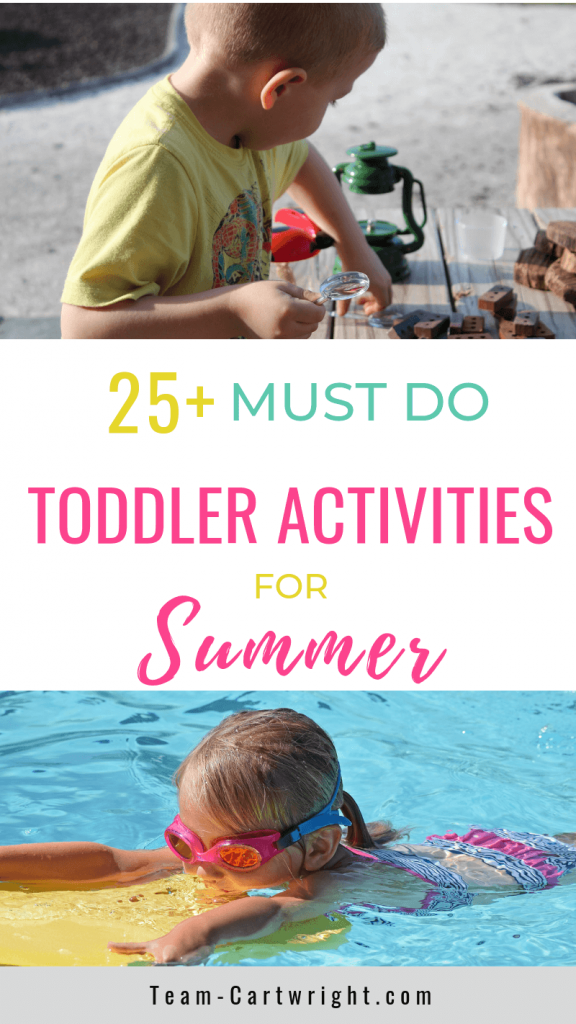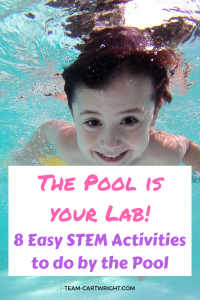Explaining scientific concept to kids: Science by the pool. Easy and fun sensory STEM activities.
Summer days are meant to be spent by the pool. Summer should be fun and relaxed. But that doesn’t mean there can’t be some fun learning involved.
The pool provides an excellent opportunity to explore some fun scientific concepts. Kids ask a lot of questions that can be hard to answer, like how do fish swim?
The water provides the perfect place to really explain concepts in a way kids can understand and experience themselves. It is a great sensory activity and sensory STEM activity. The best part is that you don’t even need to bring anything extra. You can do it all with just your child and the basic items we all have for pool time fun. (Note: These activities work in pools, kiddie pools, bathtubs, and just buckets of water.)
Get ready for science by the pool.

What's In This Post?
Safety
Before we get too into this let’s just toss out a safety reminder. Safety comes first. So make sure any sort of science activity you do in the water is appropriate for the swim level your children are at.
Science By The Pool
How Do Boats Float?
I encourage a lot of sink or float experiments, but those are just in small containers of water. Let’s think bigger. Ask your children, how do boats float? They are huge and heavy, yet they don’t sink in water.

The answer lies in buoyancy. Buoyancy is the force that pushes up against objects in the water. (Kind of the opposite of gravity.)
In order for an object to float it needs to displace (move aside) an amount of water equal to its weight. This means if a ship is 10,000 pounds it needs to be able to move 10,000 pounds of water out of the way and still have water left over to float.
A pool doesn’t have that much water, so a ship would sink. But the ocean has more than enough water to allow the ship to float. (Bonus fact: This is called Archimedes’ Principle.)
Have your child compare this to themselves floating. Kids don’t float in the bathtub. That’s because there isn’t enough water to displace compared to their weights.
For example, if your child weighs 35 pounds you would need over 35 pounds of water in the tub in order to float. There isn’t enough water. But the pool has more than enough water, making it possible to float.
Have a dinosaur fan? Check out this tasty archaeological dig!
Why Do Fish Look Like That?
This about a generic fish. Why are they shaped like that? It has to do with aerodynamics. (In the water of course.) There are certain shapes that cut through the water with ease. Other shapes would slow them down.

An easy exercise is to have your child move their hand through the water, keeping their wrist straight so the arm is a line from elbow to fingers. It moves through pretty smoothly and quickly.
Next, have your child move their wrist bent ninety degrees. It’s a lot harder to move quickly! The water doesn’t flow around as easily, slowing down the hand.
This sort of drag from the water is similar to how planes fly in the air. The narrow front of a plane allows the air to flow around it easily and upward drafts hold the plane up. Try pushing different toys through the water and seeing which move most easily!
How Do We Hear Sounds?
How do sounds move through the air and hit our ears? They move as waves. What do these waves look like? Drop something into the pool, preferably a small object with some weight to it, like a rock or even a coin. You should be able to see circular ripples moving through the water, starting where the object landed and growing outward.

These are waves. The interesting thing is that the water itself is only moving up and down, it is not being pushed out. Energy is moving outward cause the up and down motion we see, or the waves.
Sound needs a medium to move through, which particles in the air provide. Outer space is a vacuum, meaning there are no particles of anything. So there is nothing to carry along the vibrations of sound or the sound wave. This is why in space no one can hear you scream.
Keep watching your waves. Eventually, the waves hit the side of the pool. When sound waves hit your ear they vibrate your eardrums which the brain translates to sound. Watch and see if the wave bounces back off of the side of the pool. You just saw an echo!
More Activities To Try!
More Science Games
You don’t have to go into big explanations to have fun with science by the pool. Here are some simple activities for your kids.

Sink Or Float
It never gets old. What will sink and what will float? Predict first then test!
Volume Play
Use smaller containers to fill up bigger ones. Count as you go and compare big and large containers. See how water takes the shape of anything it is in. (This is a defining property of liquids!)
Condensation and Evaporation
How do materials move from one state of matter to another? Splash some water onto the deck and watch as it disappears over time. This is evaporation: liquid to gas. Bring out a cold drink and watch beads of water form outside the glass. This is condensation: gas to liquid.
Friction
Friction is the resistance one surface encounters when moving against another. Air is a surface that slows us down as we run. Water provides even more friction. Have your child run out of the water (somewhere safe of course). Then have them try to run in the water. It’s much harder because water provides greater friction!
See a Gas
Gas is the state of matter that can be the hardest for little ones to understand because it is the one we see the least. Air is clear, as compared to solids and liquids which are easy to see. Have your child blow bubbles underwater. These bubbles are full of air, a gas! The air we exhale is less dense than the water, so they float to the surface.

Conclusion
The pool provides a unique environment most kids don’t get during the rest of the year. Use it as your laboratory and let your kids explore. You can discuss the big concepts, or just let them play. The sort of play babies, toddlers, and preschoolers do in the pool is serious learning time. Help older kids think more by asking questions about what is happening in the water. You don’t need to know the answers yourself, the point is just to get them thinking about how the world around them works.

Check out the ladies of the BFBN as they explore summer fun!
Christine Keys: 5 Cheap and Easy Outdoor Activities for Toddlers
Chronicles of a Babywise Mom: What to Put in a Welcome to Summer Gift Basket for Your Kids
Mama’s Organized Chaos: Inexpensive Summer Toys That Will Keep Your Toddler Busy
Twin Mom and More: The Best Outdoor Toys for Toddlers
The Journey of Parenthood: 5 Easy Disney Themed Movie Nights













